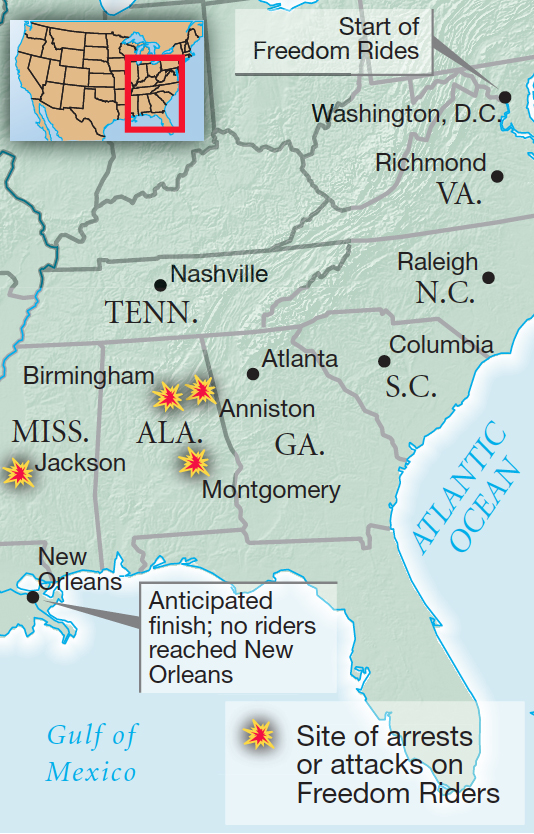The Flowering of the Black Freedom Struggle.
Printed Page 773 Chapter Chronology
The Flowering of the Black Freedom Struggle. The Montgomery bus boycott of 1955–1956 gave racial issues national visibility and produced a leader in Martin Luther King Jr. In the 1960s, protest expanded dramatically, as blacks directly confronted the people and institutions that segregated and discriminated against them: retail establishments, public parks and libraries, buses and depots, voting registrars, and police forces.
Visual Activity for Chapter 28

Massive direct action in the South began in February 1960, when four African American college students in Greensboro, North Carolina, requested service at the whites-only Woolworth's lunch counter. Within days, hundreds of young people joined them, and others launched sit-ins in thirty-one southern cities. From Southern Christian Leadership Conference headquarters, Ella Baker telephoned her young contacts at black colleges: "What are you going to do? It's time to move."
In April 1960, Baker helped student activists form a new organization, the Student Nonviolent Coordinating Committee (SNCC). Embracing civil disobedience and the nonviolence principles of Martin Luther King Jr., activists would confront their oppressors and stand up for their rights, but they would not respond if attacked. In the words of SNCC leader James Lawson, "Nonviolence nurtures the atmosphere in which reconciliation and justice become actual possibilities." SNCC, however, rejected the top-down leadership of King and the established civil rights organizations, adopting a structure that fostered decision making and leadership development at the grassroots level.
The activists' optimism and commitment to nonviolence soon underwent severe tests. Although some cities quietly met student demands, more typically activists encountered violence. Hostile whites poured food over demonstrators, burned them with cigarettes, called them "niggers," and pelted them with rocks. Local police attacked protesters with dogs, clubs, fire hoses, and tear gas, and they arrested thousands of demonstrators.

Another wave of protest occurred in May 1961, when the Congress of Racial Equality (CORE) organized Freedom Rides to integrate interstate transportation in the South. When a group of six whites and seven blacks reached Alabama, whites bombed their bus and beat them with baseball bats so fiercely that an observer "couldn't see their faces through the blood." CORE rebuffed President Kennedy's pleas to call off the rides. But after a huge mob attacked the riders in Montgomery, Alabama, Attorney General Robert Kennedy dispatched federal marshals to restore order. Freedom Riders arriving in Jackson, Mississippi, were promptly arrested, and several hundred spent weeks in jail. All told, more than four hundred blacks and whites participated in the Freedom Rides.
In the summer of 1962, SNCC and other groups began the Voter Education Project. They, too, met violence. Whites bombed black churches, threw tenant farmers out of their homes, and beat and jailed activists such as Fannie Lou Hamer. In June 1963, a white man gunned down Mississippi NAACP leader Medgar Evers in front of his house. Similar violence met King's 1963 campaign in Birmingham, Alabama, to integrate public facilities and open jobs to blacks. The police attacked demonstrators with dogs, cattle prods, and fire hoses — brutalities that television broadcast around the world.

The largest demonstration drew 250,000 blacks and whites to the nation's capital in August 1963 in the March on Washington for Jobs and Freedom, inspired by the strategy of A. Philip Randolph in 1941 (see chapter 25). Speaking from the Lincoln Memorial, King put his indelible stamp on the day. "I have a dream," he repeated again and again, imagining the day "when all of God's children . . . will be able to join hands and sing . . . ‘Free at last, free at last; thank God Almighty, we are free at last.' "
The euphoria of the March on Washington faded as activists returned to face continued violence in the South. In 1964, the Mississippi Freedom Summer Project mobilized more than a thousand northern black and white college students to conduct voter registration drives. Resistance was fierce, and by the end of the summer, only twelve hundred new voters had been allowed to register. Southern whites had killed several activists, beaten eighty, arrested more than a thousand, and burned thirty-five black churches. Hidden resistance came from the federal government itself, as the FBI spied on King and other leaders and expanded its activities to "expose, disrupt, misdirect, discredit, or otherwise neutralize" black protest.
Still, the movement persisted. In March 1965, Alabama state troopers used such violent force to turn back a voting rights march from Selma to the state capitol in Montgomery that the incident earned the name "Bloody Sunday" and compelled President Johnson to call up the Alabama National Guard to protect the marchers. Battered and hospitalized on Bloody Sunday, John Lewis, chairman of SNCC (and later a congressman from Georgia), called the Voting Rights Act, which passed that October, "every bit as momentous as the Emancipation Proclamation." Referring to the Selma march, he said, "we all felt we'd had a part in it."